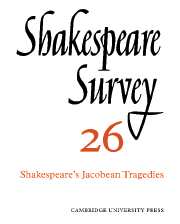Book contents
- Frontmatter
- Studies in Shakespearian and Other Jacobean Tragedy, 1918–1972: A Retrospect
- ‘Form and Cause Conjoin’d’: ‘Hamlet’ and Shakespeare’s Workshop
- The Art of Cruelty: Hamlet and Vindice
- From Tragedy to Tragi-Comedy: ‘King Lear’ as Prologue
- Jacobean Tragedy and the Mannerist Style
- ‘King Lear’ and Doomsday
- Macbeth on Horseback
- Shakespeare’s Misanthrope
- ‘Antony and Cleopatra’ and ‘Coriolanus’, Shakespeare’s Heroic Tragedies: A Jacobean Adjustment
- Shakespeare’s Venus and Adonis Sonnets
- Orlando: Athlete of Virtue
- The Unfolding of ‘Measure for Measure’
- Shakespeare and the Eye
- No Rome of Safety: The Royal Shakespeare Season 1972 Reviewed
- The Year's Contributions to Shakespearian Study 1 Critical Studies
- 2 Shakespeare’s Life, Times, and Stage
- 3 Textual Studies
- Index
- Plate section
‘Form and Cause Conjoin’d’: ‘Hamlet’ and Shakespeare’s Workshop
Published online by Cambridge University Press: 28 March 2007
- Frontmatter
- Studies in Shakespearian and Other Jacobean Tragedy, 1918–1972: A Retrospect
- ‘Form and Cause Conjoin’d’: ‘Hamlet’ and Shakespeare’s Workshop
- The Art of Cruelty: Hamlet and Vindice
- From Tragedy to Tragi-Comedy: ‘King Lear’ as Prologue
- Jacobean Tragedy and the Mannerist Style
- ‘King Lear’ and Doomsday
- Macbeth on Horseback
- Shakespeare’s Misanthrope
- ‘Antony and Cleopatra’ and ‘Coriolanus’, Shakespeare’s Heroic Tragedies: A Jacobean Adjustment
- Shakespeare’s Venus and Adonis Sonnets
- Orlando: Athlete of Virtue
- The Unfolding of ‘Measure for Measure’
- Shakespeare and the Eye
- No Rome of Safety: The Royal Shakespeare Season 1972 Reviewed
- The Year's Contributions to Shakespearian Study 1 Critical Studies
- 2 Shakespeare’s Life, Times, and Stage
- 3 Textual Studies
- Index
- Plate section
Summary
That certain analogies exist between the opening and closing scenes of Hamlet is a commonplace of criticism. Everyone sees that the figure of Old Hamlet – in his Polack-defeating armour – at the start of the tragedy is balanced by the armed figure of Fortinbras at the play’s end, fresh from his own Polack wars, restoring the status quo. And similar parallels have been pointed out, for instance, between the platform of i, i, on which the ghost of the murdered king makes his silently-eloquent appearance, and the stage on which the silently-eloquent body of his son (again with Horatio present as messenger and interpreter) is to make its last appearance after v, ii.
But what does not seem to have been generally recognised, whether in the study or in the theatre, is quite how far such apparent symmetries can be traced on further into the play; certainly far enough, at all events, to make it unlikely that in doing so one is doing nothing but finding pictures in the fire.
It is convenient to plot this underlying parallelism scene by scene; indeed, the very extent to which that is possible seems in itself to say something about ‘Shakespeare’s workshop’.
- Type
- Chapter
- Information
- Shakespeare Survey , pp. 11 - 20Publisher: Cambridge University PressPrint publication year: 1973
- 1
- Cited by

